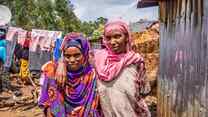Understanding, referencing, and applying the best available research are critical elements of the IRC’s approach to being an outcomes-driven and evidence-based organization. Whether it is to examine options for a crisis- response program or intervention, how a project was previously operationalized, or what activities were or were not successful in a given context, knowing the research is essential for better impact and greater effectiveness.
The IRC created Evidence Maps to make accessing and interpreting research evidence quicker and easier. With the Evidence Maps, tasks that previously required hours of desk research and a reliable internet connection can now be accomplished offline in a matter of minutes. Due to their broad appeal, IRC staff have been increasingly using them for a wide variety of purposes, including writing proposals, informing strategic planning, developing program guidance, and keeping up to date with the latest research.
The IRC has five main Evidence Maps, which assemble peer- reviewed research investigating the impact of a variety of interventions on the organization’s five main outcomes areas: health, education, economic wellbeing, safety, and power. In addition to these five, we built three cross-cutting Maps focused on cash transfer interventions, service delivery interventions, and interventions in humanitarian emergencies.
The Evidence Maps were developed using funding from the UK Department for International Development, and are based on a format adapted from the International Initiative for Impact Evaluation’s Evidence Gap Map approach.
Using the Evidence Maps
A short visual training on the Evidence Maps can be found here. The Evidence Maps organize research visually by intervention and outcome, and contain unique features that allow you to quickly filter out extraneous information. Each piece of research in the main view is supported by in-depth supporting details, which can be navigated to after you find the evidence that most interests you. This allows you to quickly switch between birds-eye views of the evidence base and more detailed views.
As a tool, Evidence Maps were primarily developed for technical advisors and other staff who need to regularly consult research as part of their job. However, Evidence Maps are available for reference and use by anyone, and are useful for
any process that benefits from readily accessible and high-quality research evidence. IRC’s Evidence Maps have assembled an unprecedented level of detail of research evidence, and can therein cater to the needs of humanitarian practitioners for both reflective and real- time application.
Going Forward
Evidence Maps are part of the IRC’s Outcomes and Evidence Framework initiative, which is developing practical resources to help standardize and streamline how the IRC designs and implements its programs and monitors progress.
The Evidence Maps are available for reference and use by both IRC staff and external actors. IRC staff will always be able to find the most up-to-date versions of the Maps in the IRC2020 portal on the ‘Outcomes and Evidence’ page. External actors can use the following links to access the IRC’s Evidence Maps:
- Education Map
- Economic Wellbeing Map
- Health Map
- Safety Map
- Power Map
- Cash Transfer Map
- Service Delivery Map
- Humanitarian Emergencies Map
Currently, the Evidence Maps primarily contain information from systematic reviews. The Evidence Maps are living documents, and are updated periodically as new research becomes available. In particular, we are currently working on improving the format of the maps so that they are even easier to use. If you have feedback or know of a systematic review that should be included in the Maps, feel free to reach out to OEF@rescue.org.



